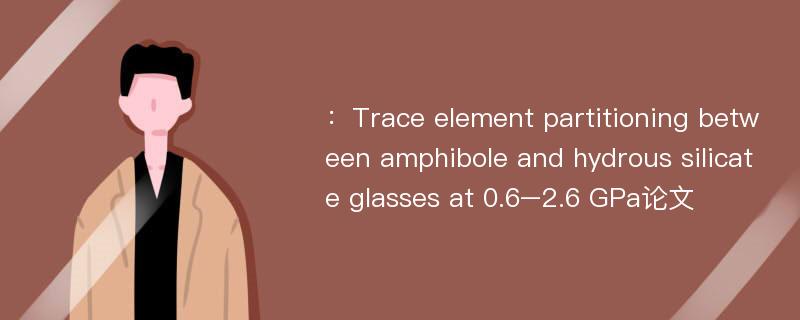
本文主要研究内容
作者(2019)在《Trace element partitioning between amphibole and hydrous silicate glasses at 0.6–2.6 GPa》一文中研究指出:Partitioning behavior between amphibole and silicate glass of thirty-three minor and trace elements(Sc,Ti, V, Cr, Co, Rb, Sr, P, Y, Zr, Nb, Cs, Ba, K, La, Ce, Pr,Nd, Sm, Eu, Gd, Tb, Dy, Ho, Er, Tm, Yb, Lu, Hf, Ta, Pb,Th, and U) have been determined experimentally. Products of crystallization of hydrous basalt melts from 0.6 GPa/860 °C up to 2.6 GPa/970 °C were obtained in a multianvil apparatus. Major and trace element compositions of amphibole and glass were determined with a combination of electron microprobe and laser ablation inductively coupled plasma mass spectrometry. The main mineral phase is calcic amphibole, and the coexisting glass compositions are tonalite, granodiorite, and granite. The compatibility of rare earth elements increase at 915 °C and then decrease at 970 °C, but the compatibility of most of these elements shows a continued, significant increase with increasing pressure. For high-field strength elements, large ion lithophile elements, actinide compatibility decrease with increasing temperature or pressure, but transition metals show a continued increase in compatibility within the temperature–pressure conditions. From mathematical and graphical fitting, we determined best-fit values for the ideal ionic radius(r0, 1.01–1.04 ?), the strain-free partitioncoefficient(D0, 1.18–1.58), and apparent Young’s modulus(E, 142–370 GPa) for the M4 site in amphibole according to the lattice strain model. The D0M4 for rare earth elements rises at 915 °C and then drops at 970 °C at 0.6 GPa.However, the D0M4 values are positively proportional to the pressure for rare earth elements in the amphibole-glass pairs at 0.6–2.6 GPa and 970 °C. Furthermore, the derived best-fit values for r0M4 and EM4 are almost constant and trend to increase with rising temperature and pressure,respectively. The partition coefficient is distinctly different for different melt compositions. The rare earth elements become more enriched in amphibole if the quenched glass is granodiorite or granite compared to the tonalitic glasses.
Abstract
Partitioning behavior between amphibole and silicate glass of thirty-three minor and trace elements(Sc,Ti, V, Cr, Co, Rb, Sr, P, Y, Zr, Nb, Cs, Ba, K, La, Ce, Pr,Nd, Sm, Eu, Gd, Tb, Dy, Ho, Er, Tm, Yb, Lu, Hf, Ta, Pb,Th, and U) have been determined experimentally. Products of crystallization of hydrous basalt melts from 0.6 GPa/860 °C up to 2.6 GPa/970 °C were obtained in a multianvil apparatus. Major and trace element compositions of amphibole and glass were determined with a combination of electron microprobe and laser ablation inductively coupled plasma mass spectrometry. The main mineral phase is calcic amphibole, and the coexisting glass compositions are tonalite, granodiorite, and granite. The compatibility of rare earth elements increase at 915 °C and then decrease at 970 °C, but the compatibility of most of these elements shows a continued, significant increase with increasing pressure. For high-field strength elements, large ion lithophile elements, actinide compatibility decrease with increasing temperature or pressure, but transition metals show a continued increase in compatibility within the temperature–pressure conditions. From mathematical and graphical fitting, we determined best-fit values for the ideal ionic radius(r0, 1.01–1.04 ?), the strain-free partitioncoefficient(D0, 1.18–1.58), and apparent Young’s modulus(E, 142–370 GPa) for the M4 site in amphibole according to the lattice strain model. The D0M4 for rare earth elements rises at 915 °C and then drops at 970 °C at 0.6 GPa.However, the D0M4 values are positively proportional to the pressure for rare earth elements in the amphibole-glass pairs at 0.6–2.6 GPa and 970 °C. Furthermore, the derived best-fit values for r0M4 and EM4 are almost constant and trend to increase with rising temperature and pressure,respectively. The partition coefficient is distinctly different for different melt compositions. The rare earth elements become more enriched in amphibole if the quenched glass is granodiorite or granite compared to the tonalitic glasses.
论文参考文献
论文详细介绍
论文作者分别是来自Acta Geochimica的,发表于刊物Acta Geochimica2019年03期论文,是一篇关于,Acta Geochimica2019年03期论文的文章。本文可供学术参考使用,各位学者可以免费参考阅读下载,文章观点不代表本站观点,资料来自Acta Geochimica2019年03期论文网站,若本站收录的文献无意侵犯了您的著作版权,请联系我们删除。
